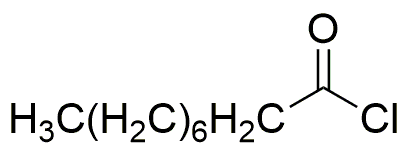Nonanoyl chloride is widely utilized in research focused on:
- Synthesis of Esters: It serves as a key reagent in the production of nonanoic acid esters, which are used in flavoring and fragrance industries, providing a fruity aroma.
- Pharmaceutical Intermediates: This compound is essential in the synthesis of various pharmaceutical agents, enhancing the efficacy of drug formulations through improved bioavailability.
- Surfactant Production: Nonanoyl chloride is used in creating nonionic surfactants, which are vital in personal care products like shampoos and lotions for their emulsifying properties.
- Polymer Chemistry: It plays a role in modifying polymers to improve their properties, such as adhesion and flexibility, making it valuable in coatings and adhesives.
- Research Applications: In laboratory settings, it is utilized for studying reaction mechanisms and developing new synthetic pathways, aiding researchers in discovering innovative chemical processes.
General Information
Properties
Safety and Regulations
Applications
Nonanoyl chloride is widely utilized in research focused on:
- Synthesis of Esters: It serves as a key reagent in the production of nonanoic acid esters, which are used in flavoring and fragrance industries, providing a fruity aroma.
- Pharmaceutical Intermediates: This compound is essential in the synthesis of various pharmaceutical agents, enhancing the efficacy of drug formulations through improved bioavailability.
- Surfactant Production: Nonanoyl chloride is used in creating nonionic surfactants, which are vital in personal care products like shampoos and lotions for their emulsifying properties.
- Polymer Chemistry: It plays a role in modifying polymers to improve their properties, such as adhesion and flexibility, making it valuable in coatings and adhesives.
- Research Applications: In laboratory settings, it is utilized for studying reaction mechanisms and developing new synthetic pathways, aiding researchers in discovering innovative chemical processes.
Documents
Safety Data Sheets (SDS)
The SDS provides comprehensive safety information on handling, storage, and disposal of the product.
Product Specification (PS)
The PS provides a comprehensive breakdown of the product’s properties, including chemical composition, physical state, purity, and storage requirements. It also details acceptable quality ranges and the product's intended applications.
Certificates of Analysis (COA)
Search for Certificates of Analysis (COA) by entering the products Lot Number. Lot and Batch Numbers can be found on a product’s label following the words ‘Lot’ or ‘Batch’.
*Catalog Number
*Lot Number
Certificates Of Origin (COO)
This COO confirms the country where the product was manufactured, and also details the materials and components used in it and whether it is derived from natural, synthetic, or other specific sources. This certificate may be required for customs, trade, and regulatory compliance.
*Catalog Number
*Lot Number
Safety Data Sheets (SDS)
The SDS provides comprehensive safety information on handling, storage, and disposal of the product.
DownloadProduct Specification (PS)
The PS provides a comprehensive breakdown of the product’s properties, including chemical composition, physical state, purity, and storage requirements. It also details acceptable quality ranges and the product's intended applications.
DownloadCertificates of Analysis (COA)
Search for Certificates of Analysis (COA) by entering the products Lot Number. Lot and Batch Numbers can be found on a product’s label following the words ‘Lot’ or ‘Batch’.
*Catalog Number
*Lot Number
Certificates Of Origin (COO)
This COO confirms the country where the product was manufactured, and also details the materials and components used in it and whether it is derived from natural, synthetic, or other specific sources. This certificate may be required for customs, trade, and regulatory compliance.

